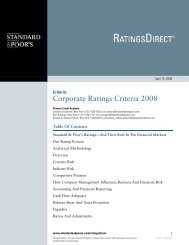European Infrastructure Finance Yearbook - Investing In Bonds ...
European Infrastructure Finance Yearbook - Investing In Bonds ...
European Infrastructure Finance Yearbook - Investing In Bonds ...
You also want an ePaper? Increase the reach of your titles
YUMPU automatically turns print PDFs into web optimized ePapers that Google loves.
TRANSPORTATION INFRASTRUCTURE<br />
54 ■ NOVEMBER 2007<br />
(BIA; A-/Stable/A-2) showed negative 0.5%<br />
growth in the first half of 2007: the semi-annual<br />
figure suggests traffic is however decreasing less<br />
rapidly than in full-year 2006 (2.5%). Second-half<br />
2007 and 2008 will be crucial to confirm whether<br />
this decline suggests a departure from BIA’s longterm<br />
growth trend.<br />
Improved profitability and cash flow generation<br />
overall but pressures mounting for some airports<br />
We expect most rated <strong>European</strong> airports’ EBITDA<br />
to improve in 2007, on the basis of more traffic,<br />
increases in airport charges, higher nonaeronautical<br />
revenues, and the implementation of<br />
cost-cutting measures. Reported interim accounts<br />
at June 30, 2007 by ADP, Brussels, Copenhagen<br />
or Schiphol airports support that view; only<br />
Aeroporti di Roma SpA (AdR; BBB/Watch Neg/<br />
A-2) is showing a negative evolution. The disposal<br />
of ADR Handling and Italy’s 2007 budget law<br />
impacted AdR’s reported EBITDA, which was<br />
down 2.9% against the first semester of 2006.<br />
Without this, EBITDA would have grown by<br />
3.4%.<br />
<strong>In</strong>creased security and utilities costs could<br />
hamper EBITDA growth, however, particularly if<br />
rising costs are not offset by sufficient traffic and<br />
revenue growth or cost control. Brussels Airport<br />
reported a strong 14% EBITDA growth in its<br />
2007 interim accounts, illustrating management’s<br />
ability to cut operating costs; not all airports have<br />
such a track record and pressures could rise in the<br />
short to medium term for some of them.<br />
<strong>In</strong> some <strong>European</strong> regional airports (notably in<br />
the U.K.) aeronautical revenue is set to grow<br />
more slowly than passenger volume in the future,<br />
reflecting price incentives offered to grow traffic<br />
levels and the increasing proportion of low-cost<br />
traffic. This is due to smaller airports increasingly<br />
competing with more established regional hubs,<br />
as well as a continuing shift in market segments<br />
resulting in a growing reliance on low-cost traffic.<br />
Aeronautical yields per passenger have actually<br />
started to decline at Manchester Airport Group<br />
PLC (MAG; A/Stable/--) and the same could<br />
happen at BIA due to the company’s growing<br />
exposure to low-cost traffic and aggressive pricing<br />
competition. So far, decline in aeronautical<br />
income has been offset by the resilience of<br />
nonaeronautical income. That might not always<br />
be the case, though, and ultimately steady cash<br />
flow generation could be at risk.<br />
STANDARD & POOR’S EUROPEAN INFRASTRUCTURE FINANCE YEARBOOK<br />
Most airports have benefited from increasing<br />
revenues and profits from their real estate-related<br />
businesses in the past years. Future contributions<br />
from that segment could shrink or prove less<br />
buoyant than in the past if the business and<br />
commercial real estate markets stabilize or decline<br />
after several years of sustained growth. We will<br />
continue monitoring airports’ strategies in real<br />
estate, its stability as a revenue source, and if any<br />
property development risks are being taken that<br />
we would consider as weakening the airport’s<br />
business risk profile.<br />
Governance and financial aspects paramount for<br />
future ratings stability<br />
The rating implications of overall higher<br />
profitability and stronger internal cash flow<br />
generation will depend on the use shareholders<br />
make of additional cash flow: The funding of<br />
capital spending or capital structure improvement<br />
will be neutral to positive from a credit<br />
perspective. Conversely, increasing distribution<br />
payout or M&A activity could put some pressure<br />
on the ratings.<br />
A clear example of that is Brussels Airport.<br />
Profitability and cash flow generation have been<br />
on the rise following the 2005 privatization, but<br />
we lowered the rating to ‘BBB’ from ‘BBB+’ in<br />
June 2007, following a significant special<br />
distribution of €310 million to shareholders<br />
(subject to meeting certain performance hurdles).<br />
As the company was operating under a financing<br />
structure limiting extraordinary dividends,<br />
the shareholders had to make a recapitalization to<br />
repay existing debt in order to make<br />
their distribution.<br />
Looking ahead, it is crucial that airports<br />
maintain good credit quality and access to<br />
external funding for their capital expenditures<br />
and refinancing needs. <strong>In</strong> this respect, not only do<br />
operational and financial performance matter<br />
but ownership and governance are also key<br />
credit factors.<br />
<strong>In</strong>creasingly complex structures are being put in<br />
place in order to extract money from the airport<br />
operating companies for distribution and/or<br />
refinancing of acquisition debt, due to a spike in<br />
investor interest in acquiring airports. Standard &<br />
Poor’s rigorously examines ownership<br />
arrangements and changes so as to measure the<br />
debt obligations that are, directly or indirectly,<br />
supported by an airport’s operations. <strong>In</strong> June



